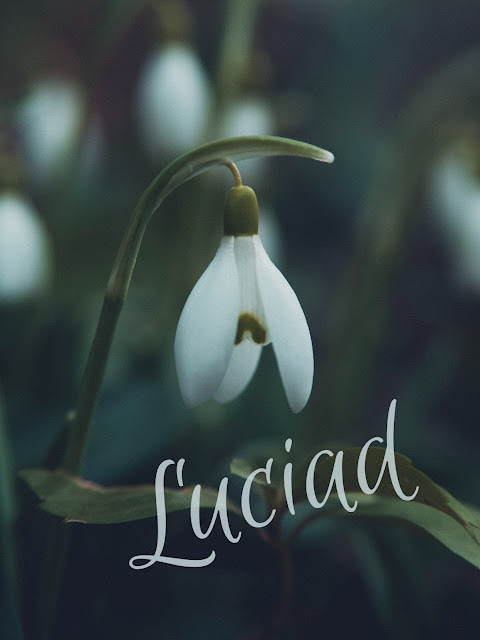Snowdrop Days
Luciad is a celebration of light and the earliest signs of spring. The Spring or Vernal Equinox in March is technically the midpoint of the season, though we mark it on modern calendars as the start of the season, so spring has begun to arrive; depending on where you are in the world this may be more or less apparent. Here in the desert, it is still cold but the earliest buds of pale green begin to show on the trees. Before long, summer's heat will start to send its tendrils our way and the soft greens will mature into somber dark grey-greens, but for now the world feels young and exciting!
Snowdrops, as I wrote last year, are the symbol of Luciad. This tiny little flower requires the cold to bloom, and rises in February and March, though can be seen as early as January if the winter has been mild. In their wooded European homelands, these blooms are the first signs of spring and warmer weather on the way. They are thus a very appropriate symbol for the festival that marks the first moments of the Eastre cycle, where the Daughter willingly takes on Her fate to go down into the darkest place of all. Relevant Scriptures for this festival would be 1:6:8-21 (NCU)/Mythos of the Divine Maid 3:8-21 (ECE). Myths surround the Snowdrop, one being that after Eve was expelled from the garden of Eden, her tears fell to the earth and bloomed as snowdrops; or that an angel was sent to comfort Eve in her sorrow: the angel then scattered snowflakes which, as they landed, bloomed into snowdrops; that snowdrops bloomed in the footprints of the Daughter as She walked toward Her fate; and this lovely Romanian story that seems eerily familiar!
...each year the Sun took the form of a beautiful young girl to warm the
earth in the spring. The people loved her and looked forward to her
appearance with the greatest pleasure. One day, the monster of Winter
known as a Zmeu kidnapped her and hide her in a dungeon. The world
became a dark and sad place. The birds sang no more and the waters fell
silent. The Sun could not even think that she could escape from the
dungeon, until the young man named Hero set her free. However, the poor
Hero was wounded and, despite Sun’s warmth, he fell to the ground. He
let his blood drop on the floor and the first Snowdrops began to grow,
symbolizing the new life and renewal. (from here, also see here.)
A Note: Please be careful if you have snowdrops, as they are toxic to humans and pets -- handle the bulbs with gloves! -- a fact reflected in superstitions that to bring snowdrops inside would result in a death in the family, and folk names such as Death's Flower and Drooping Heads.
Luciad is also known as the Feast of Lights as it celebrates the light of the Daughter (v 18-21 from the Scripture reading) by blessing candles. All candles you have should be blessed on this day; burning the candles blessed on the Feast of Lights is said to protect from evil, so if you have only a few candles on hand, you may wish to use them for specific rites or times of the year when you feel you need extra help. The Madrian rite for blessing candles may be performed by anyone by making the sign of the pentacle over the candles and saying: “May our Lady’s blessing rest upon these waxen creatures.” You may also use the Fora (which looks like a plus sign enclosed in a circle), or another sign that your denomination prefers.



Comments
Post a Comment